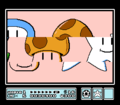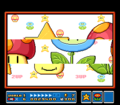Spade Panel
| Spade Panel | |
|---|---|
| First appearance | Super Mario Bros. 3 (1988) |
| Latest appearance | Super Mario All-Stars Limited Edition (2010) |
Spade Panels,[1][2] also known as Flip Games[3] or Spade Houses,[4] are small panels on overworld maps in Super Mario Bros. 3 that can be used to earn extra lives for Mario or Luigi. Once the player enters one, they can play a minigame hosted by a Toad. Its gameplay is similar to that of a slot machine, in which parts of pictures slide past on panels and the player must line up three of the same panel to make a picture and win extra lives. There are Mushroom, Flower, and Star icons, granting two, three, and five extra lives when lined up as the Mushroom Picture,[1][2] the Flower Picture,[1][2] and the Star Picture,[1][2] respectively, similar to the goal at the end of nearly every level. If any of the panels are mismatched, no extra lives are awarded.
In Super Mario Advance 4: Super Mario Bros. 3, if a Spade Panel is matched up correctly, further Spade Panels change to Heart Panels. The Stars are replaced by Leaf icons that give seven extra lives. Clearing one of these turns further Heart Panels into Club Panels, and the Super Leaves change to "3" icons that reward 10 extra lives. Clearing a Club Panel turns further panels into Diamond Panels, where only one picture can be lined up, making it impossible to lose. Earning a minimal number of lives at previous panels results in a Mushroom Picture, while higher numbers yield a random picture, and each picture gives the corresponding number of extra lives. If the player clears a Diamond Panel, or fails at any of the other ones, then all panels revert to Spade Panels, restarting the process. Clearing all levels makes all Spade Panels reusable.
A special Spade Panel, the N-Mark Spade Panel, appears every 80,000 points. When it is activated, the player plays a card game for prizes, with a total of nine prizes per game. After the game, all prizes earned are included in the player's inventory. Unlike with the other Spade Panel games, a player can make two mistakes during an N-Mark Spade Panel game before being returned to the world map; when the next 80,000 points are achieved, they can continue the game from where they left off.
In Super Mario Maker 2, while the Spade Panel itself does not appear, its minigame reappears as part of the version 3.0.0 update in one of the Toad Houses the player can place on the world map in World Maker. They are distinguished by the Super Star on the Toad House's roof.
Gallery
Super Mario Bros. 3
Super Mario All-Stars
Super Mario Advance 4: Super Mario Bros. 3
Names in other languages
| Language | Name | Meaning | Notes |
|---|---|---|---|
| Japanese | スペードパネル[5] Supēdo Paneru |
Spade Panel | |
| Italian | Quadro del segno di picche[6] Pannello picche[7] |
Spade symbol square Spade panel |
Trivia
- This minigame's theme music is arranged in Super Mario RPG: Legend of the Seven Stars (for Grate Guy's Casino), Super Mario 64 DS, New Super Mario Bros. (both for the minigames Wanted!, Connect the Characters, and Mario's Slides), Paper Mario: Sticker Star, Paper Mario: Color Splash (both for Snifit or Whiffit), Mario Party: Island Tour (for the minigame theme "Slowly Bubble Up"), and Super Mario Odyssey (for the Slots minigame).
- This minigame's theme music in Super Mario Bros. 3 is a looped sample from the bass-line (or pause music) from Super Mario Bros. 2's ground theme.
- Much like the case with Bowser's wristbands from the original Super Mario Bros., in the sprites for Mario and the Toad in the Spade Panel cutscene, due to the NES supporting just three colors for each sprite, Mario/Luigi's gloves and the white parts of the Toad's body, including the primary color for his mushroom "hat" and pants, are actually transparent and appear white due to the sprites appearing in front of a white background. This also results in the Toad gaining an orange pixel (formed from the brick outlines of the wall) on his sprite if one looks closely enough.
References
- ^ a b c d Super Mario All-Stars instruction booklet, pages 31–32
- ^ a b c d Super Mario Bros. 3 English instruction booklet, page 21
- ^ Super Mario Advance 4: Super Mario Bros. 3 Player's Guide, page 18
- ^ Super Mario Advance 4: Super Mario Bros. 3 Prima's Official Strategy Guide back cover
- ^ Super Mario Bros. 3 Japanese instruction booklet, page 19.
- ^ Super Mario Bros. 3 Italian manual, pag. 16
- ^ Super Mario All-Stars 25th Anniversary Edition Italian manual, pag. 17







